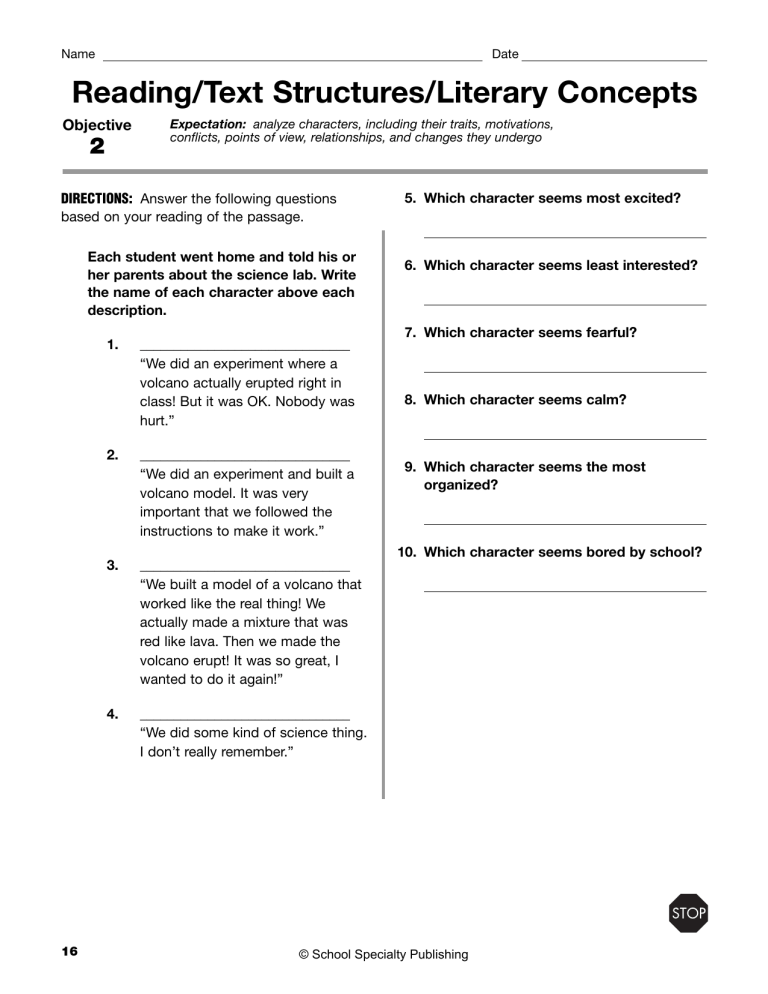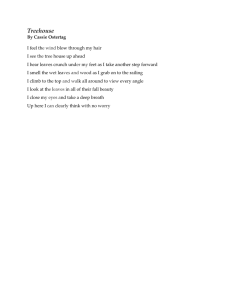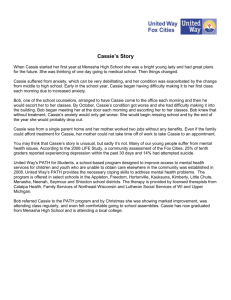
Name Date Reading/Text Structures/Literary Concepts Objective 2 Expectation: analyze characters, including their traits, motivations, conflicts, points of view, relationships, and changes they undergo DIRECTIONS: Answer the following questions based on your reading of the passage. Each student went home and told his or her parents about the science lab. Write the name of each character above each description. 1. 16 _______________________________ “We did an experiment where a volcano actually erupted right in class! But it was OK. Nobody was hurt.” 2. _______________________________ “We did an experiment and built a volcano model. It was very important that we followed the instructions to make it work.” 3. _______________________________ “We built a model of a volcano that worked like the real thing! We actually made a mixture that was red like lava. Then we made the volcano erupt! It was so great, I wanted to do it again!” 4. _______________________________ “We did some kind of science thing. I don’t really remember.” 5. Which character seems most excited? 6. Which character seems least interested? 7. Which character seems fearful? 8. Which character seems calm? 9. Which character seems the most organized? 10. Which character seems bored by school? © School Specialty Publishing Name Date Reading/Text Structures/Literary Concepts Objective 2 Expectation: recognize and analyze story plot, setting, and problem resolution DIRECTIONS: Read the passage and answer the questions on page 18. Minnie the Mole Minnie the Mole and her five children live in a cozy burrow under Mr. Smith’s garden. Minnie works hard gathering insects and worms, her five children’s favorite treats. It is not an easy job since moles eat their own weight in food each day. Mr. Smith did not like the raised roofs of Minnie’s tunnels in his garden. One hot summer day, as Minnie was digging through the bean patch with her sharp claws, she heard a new sound. Although she has no external ears, Minnie can hear very well. Mr. Smith was pounding a trap into position at the front entrance to her burrow. Minnie hurried home and gathered her children around her. “We are in danger! We must move quickly. Get in line and follow me,” demanded Minnie. The little moles with their short, stocky bodies and long snouts did as their mother told them. Minnie started digging a tunnel in the soft soil as fast as she could. “We’re going to Uncle Marty Mole’s burrow. We’ll be safer there,” Minnie said. She and the children worked tirelessly for two hours. They were far from Mr. Smith’s garden now. Tired, but safe, the little group rested in the comfort of Uncle Marty’s living room. “You were busy as beavers today,” said Uncle Marty. “I’d say we were more like a ‘mole machine’!” laughed Minnie. © School Specialty Publishing 17 Name Date Reading/Text Structures/Literary Concepts Objective Expectation: recognize and analyze story plot, setting, and problem resolution 2 DIRECTIONS: Answer the questions about the story. 1. The main character is __________________________________________________________________ . 2. The first setting for the story is ________________________________________________________________ . 3. Mr. Smith didn’t like having moles in his garden because ________________________________ . 4. Minnie’s problem was that Mr. Smith ___________________________________________________ . 5. First, Minnie told her children to ___________________________________________________________. 6. They dug for __________________________________________________________________________ . 7. The problem was solved when __________________________________________________________ . 8. Uncle Marty said Minnie and her children had worked like _______________________________ . 9. Minnie said they had worked more like a _______________________________________________ . 18 © School Specialty Publishing Name Date Objective For pages 15–18 Mini-Test 2 DIRECTIONS: Read the story, then answer the questions. Cassie’s mom has errands to run, so Cassie agrees to stay home to babysit for her little brother, who is asleep. Her mom also leaves Cassie a list of chores to do while she is gone. Cassie will be able to go to the mall with her friends when her chores are finished and her mom gets back. As soon as Cassie’s mom leaves, Cassie starts calling her friends on the phone. She talks to Kim for 20 minutes and to Beth for 15 minutes. She is supposed to call Maria when she finishes talking to Jackie. After talking on the phone, Cassie decides to do her nails while she watches a movie on TV. After the movie, Cassie listens to the radio and reads a magazine. Before Cassie realizes it, three and a half hours have passed and her mom is back home. Her mom walks in and finds the kitchen still a mess, crumbs all over the carpet, dusty furniture, and Cassie’s little brother screaming in his room. 1. What is the setting for this story? 4. Which of the following is a chore Cassie probably wasn’t supposed to do? A the mall B Cassie’s house F dust C Jackie’s house G listen for her brother D the kitchen H do her nails J clean the kitchen 2. What do we know about the main character? F she has errands to run G she has chores to do H he is asleep J he is screaming in his room 3. What is the plot of this story? A Cassie must do her chores if she wants to go to the mall. But, she wastes the time instead. B Cassie’s mother has errands to run. She leaves Cassie in charge of the house. C Cassie’s brother is asleep in his room. He wakes up screaming. D Cassie is grounded. 5. What do you think the resolution to this problem will be? A Cassie’s little brother will have to do all the chores. B Cassie will be punished and will not go to the mall. C Cassie’s mom will drive her to the mall. D Cassie, her mom, and her brother will go to a movie. © School Specialty Publishing 19 TAKS Reading—Objective 3 The student will use a variety of strategies to analyze culturally diverse written texts. (4.10) Reading/comprehension The student comprehends selections using a variety of strategies. The student is expected to (E) use the text’s structure or progression of ideas such as cause and effect or chronology to locate and recall information (4–8); (See page 21.) (I) find similarities and differences across texts such as in treatment, scope, or organization (4–8); and (See page 22.) (L) represent text information in different ways such as in outline, timeline, or graphic organizer (4–8). (See page 23.) (4.12) Reading/text structures/literary concepts The student analyzes the characteristics of various types of texts (genres). The student is expected to (A) judge the internal consistency or logic of stories and texts such as “Would this character do this?”; “Does this make sense here?” (4–5); (See page 24.) (C) identify the purposes of different types of texts such as to inform, influence, express, or entertain (4–8); (See page 25.) (E) compare communication in different forms such as [contrasting a dramatic performance with a print version of the same story or] comparing story variants ((2–8); and (See page 26.) (J) describe how the author’s perspective or point of view affects the text (4–8). (See pages 27–28.) What it means: ● 20 Genre is a type, or category, of literature. Some examples of genre include fiction, biographies, poetry, and fables. Each genre is characterized by various differences in form. For example, a fable differs from the broader category of fiction in that it has a moral or character lesson. © School Specialty Publishing



